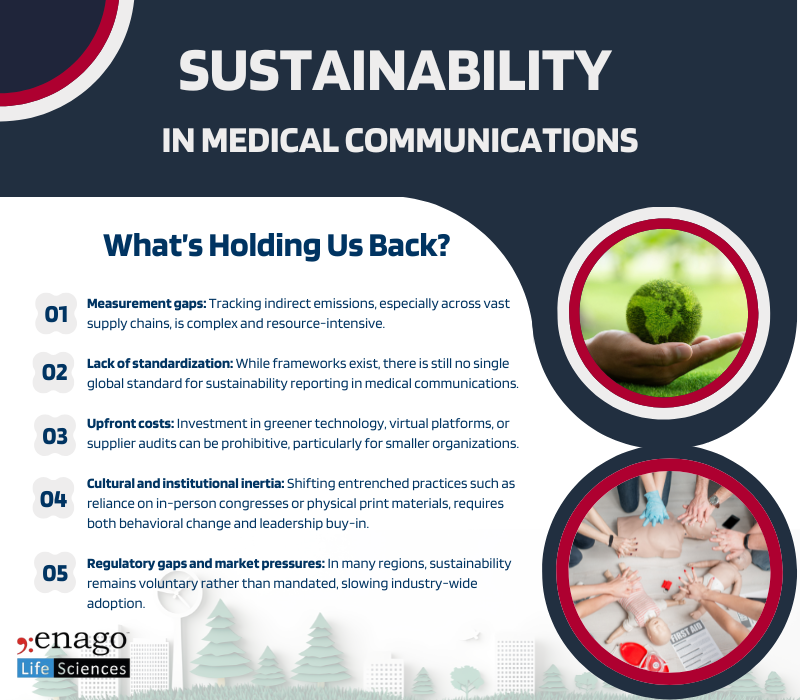Executive Summary
Sustainability will be central to how the industry must operate in the coming decades. When applied to medical communications, sustainability refers to adopting practices that are efficient, ethical, and equitable. This article examines the environmental footprint of medical communications, the shifts already underway, the economics of sustainable practices, the barriers ahead, and the practical steps professionals can take to drive meaningful change.
Why Sustainability Now?
According to the World Health Organization (WHO), climate change will cause up to 250,000 additional deaths annually between 2030 and 2050, through malnutrition, malaria, diarrhea, and heat stress. Healthcare, ironically dedicated to saving lives, remains a significant contributor to this crisis. This puts medical communicators, who sit at the intersection of science, industry, and public health, in a unique position of responsibility.
The Carbon Footprint of Medical Communications
Globally, the healthcare is responsible for an estimated 4.4–5.2% of greenhouse gas (GHG) emissions, a share larger than that of the entire aviation sector. Within this footprint, the pharmaceutical sector produces more emissions than the automotive industry, driven primarily by energy-intensive manufacturing and supply chains.
In medical communications, the key contributors to carbon emissions are familiar:
- Print publications that rely on paper, ink, and distribution logistics.
- Large international conferences associated with air travel, hotel stays, and venue energy use.
- Pharma manufacturing and supplier logistics, which indirectly influence into the communication chain.
- Travel emissions for staff meetings, advisory boards, and patient engagements.
Breaking down emissions using the Scope 1–3 framework offers clarity:
- Scope 1: Direct emissions from owned operations.
- Scope 2: Indirect emissions from purchased energy.
- Scope 3: All other indirect emissions across the value chain, including supply chain activities, equipment, and travel.
In healthcare, Scope 3 emissions account for around 71% of total emissions. For medical communications specifically, conference travel and supplier logistics are among the heaviest contributors. This is where innovation and behavior change can make a measurable difference.
Industry Shifts: Are medical writers and healthcare organizations ready?
The good news is that the industry is already adapting. The pandemic accelerated trends that now form the backbone of sustainable medical communications:
- Virtual and hybrid conferences reduces the need for large-scale international travel.
- Digital-first publishing and reduced print runs help minimize paper waste.
- Eco-friendly digital platforms are emerging, emphasizing energy efficiency in data hosting and dissemination.
- Green pharmacy practices, from responsible procurement to environmentally safe disposal, are gaining traction.
Standardization of sustainability metrics and reporting frameworks is helping organizations benchmark progress and hold themselves accountable. The UK National Health Service (NHS) reduced its carbon emissions by 18.5% over a decade, demonstrating that systemic change is possible within a major healthcare provider. Kaiser Permanente, a U.S. healthcare giant, cut emissions by 29% since 2008, partly by transitioning to renewable energy and rethinking procurement. For medical writers, this translates into a need for fluency in both scientific communication and sustainability discourse.
Health Economics of Sustainability in MedComms
Sustainability in medical communications is good for the planet but it also makes economic sense. Cutting waste and improving efficiency can lead to substantial cost savings. Waste management, eco-friendly procurement, and smarter use of technology support budget stability. Beyond operational savings, sustainability can feed into Health Technology Assessments (HTA), which now increasingly consider environmental impacts as part of cost-effectiveness and value-based decision models. Incorporating sustainability factors can improve a technology’s or intervention’s appraisal, enhancing its chances of regulatory approval and expanding market access.
Moreover, reducing resource overuse and waste aligns with health economics goals of optimizing finite budgets while ensuring equitable access. Sustainable innovation in medical communications like greener supply chains, reduced carbon footprint platforms, and less travel supports system long-term resilience. These changes help healthcare organizations maintain budget stability amid mounting financial pressures and climate risks. Thus, delivering a triple bottom line: environmental benefits, improved health outcomes, and substantial cost efficiencies, which strengthens the value proposition for sustainable healthcare.
Despite clear opportunities, significant challenges remain:

These barriers highlight the need for cross-sector collaboration, policy support, and advocacy from within the medical communications community.
Practical Steps for Medical Writers and Organizations
Medical writers and healthcare communicators have a direct role to play in advancing sustainability. Practical actions include:
- Prioritize digital-first strategies: Opt for virtual congresses, hybrid events, and digital publishing wherever possible. Ensure that platforms are energy-efficient and accessible.
- Embed sustainability in content: Highlight eco-friendly practices in publications, and advise clients on how communication strategies can align with sustainability goals.
- Choose green suppliers: Partner with vendors who demonstrate transparent sustainability commitments, from recycled materials to renewable energy use.
- Adopt transparent metrics: Use lifecycle assessment tools and carbon calculators to measure and report emissions associated with communication activities.
- Advocate for equity: Design strategies so that sustainability efforts also expand access for instance, by making virtual conferences more inclusive for researchers in low-resource settings.
By adopting these practices, medical communicators not only reduce their environmental footprint but also reinforce credibility and trust among healthcare stakeholders.
Ready for Change?
The transformation toward sustainable medical communications is already in motion, driven by environmental urgency, economic logic, and shifting cultural expectations. But it requires leadership, accountability, and an industry-wide cultural shift.
Medical writers and healthcare professionals are uniquely positioned to lead this change. By championing sustainability in both content and operations, they can help align medical communications with broader public health goals. The facts and economic incentives align: substantial savings and health gains are possible, but readiness must expand beyond technical fixes to include systemic, cultural, and policy-driven changes. This sector holds the power to drive public health and environmental progress if industry leaders act together.
Author:

Rebecca D’souza, PhD.
Associate Content Expert, Enago Academy
Connect with Rebecca on LinkedIn

